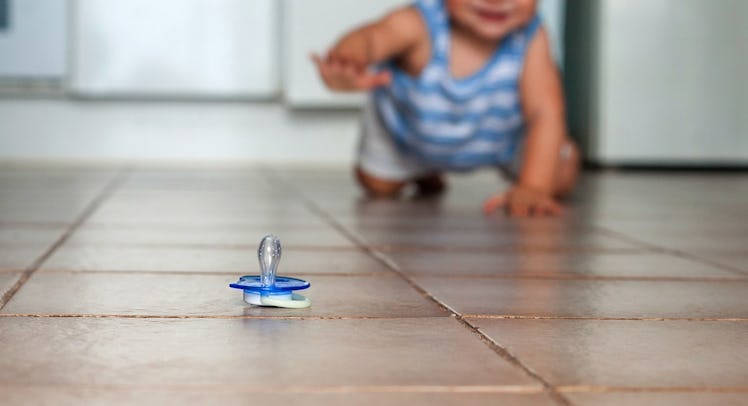How to Care For, Clean, and Maintain Baby Pacifiers
When the pacifier, binky, or sucky gets dropped, it’s good to have more on hand or find some warm water for a rinse before handing it back to a child.

Pacifiers are undoubtedly good for infants and babies. For instance, the American Academy of Pediatrics (AAP) has found that a binky, suckey, or paci used for sleep can decrease the risk of SIDS. A pacifier also gives babies a tool to help them self-soothe in moments of anxiety. But while all of those things are great for a kid, pacifiers can also present something of a hygiene nightmare. That’s because they are routinely dropped, traded with other babies, chomped on, and otherwise abused. And parents often don’t consider the care required to keep the baby-plugs clean. That can find kids being needlessly exposed to any number of gross paci-related health issues. Luckily it’s not that tough to up the pacifier care game.
Importantly, for pacifier care to not cause disruption in a kids life, it’s helpful to have plenty on hand. That way, as pacifiers are cleaned or disposed of, the baby still has one handy. Multiple clean pacifiers should also be packed in diaper bags and cars. Necessity has driven many a parent to desperately wipe off a filthy pacifier or even take one for the team and swish the dirty binky around in their own mouth to “clean” it before giving it back to their kid.
How to Care for a Pacifier
- Refrain from cleaning a pacifier with your own mouth.
- If a pacifier is dropped clean it with soap and water, or use a breastmilk or warm water rinse in a pinch.
- Wash pacifiers with soap and water daily, or run them through the dishwasher a couple times a week.
- Dispose of any pacifiers that look worn or have obvious cracks.
- Keep many duplicate clean pacifiers on hand so they can be easily switched out.
“I usually advise against cleaning a baby’s paci with your own mouth as you can pass adult bacteria to your baby that can cause cavities,” explains pediatrician Dr. Tanya Altmann, a spokesperson for AAP and author of Baby and Toddler Basics. “Also, you can swap germs either way that may cause illnesses from colds to cold sores.”
The better way to provide emergency pacifier cleaning while out and about is to use warm soapy water, according to Altmann. Though she does note that a rinse in breastmilk or just warm water by itself will do in a pinch. And lest parents assume that knocking the dirt of a dropped binky and giving it back is good for the kid’s immune system, Altmann notes, “Although some germs are good, others are bad and I’m more worried about dog poop and pesticides from bottoms of shoes.”
RELATED: The Pros And Cons Of Using A Baby Pacifier
For daily pacifier care, Altmann notes that a simple nightly soapy water wash and air dry will work to keep pacifiers clean. Though, as an alternative, she notes that popping them in the dishwasher a couple of times a week will also work. It’s good to develop this habit early, too. Some babies get just as picky about the flavor of their pacifier as they do about its shape. If parents wash pacifiers irregularly, babies may reject the clean ones and become fussy because they do not taste the same.
Because pacifiers are often used as objects of comfort, they have a tendency to get worn out by babies that need them wherever they go. Altmann points out that part of pacifier maintenance is knowing when to dispose of them. “Once they start looking worn out or have any breaking or cracked parts, it’s best to toss them and get new ones,” she says.
Throwing away a pacifier can be a tough task for parents who see a well-loved, but otherwise completely serviceable binky. Particularly if the only problem is that a crack makes the pacifier noisy. But there’s another danger in the cracks aside from random squeaks and gurgling sounds.
MORE: 6 Myths About How Pacifiers Work Parents Should Ignore
“Although baby products are now BPA free, there are still other things in the pacifier material that with lots of washing and breakdown may leach out,” explains Altmann. She notes the same rules goes for all plastic baby products. “Whether pacifiers or bottles or plates, it’s a good idea to replace if worn or any broken down pieces. This is also for safety. In case a piece actually breaks off it could become a choking hazard or cause injury if sharp.”
Again, this points to the necessity of having extra clean pacifiers on hand. Because while a broken, dirty pacifier might be hazardous to a baby’s health, not having one around at all when needed is hazardous to parental nerves.